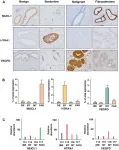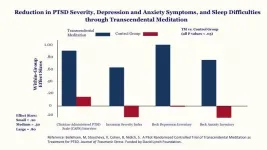(Press-News.org) A set of surveys fielded last year found that a large majority of U.S. adults support COVID-19 mitigation measures, including indoor mask wearing, social distancing, and contact tracing, with significant differences across certain groups. The surveys, which followed the same people in April, July, and November 2020, were conducted by a team of researchers at the Johns Hopkins Bloomberg School of Public Health with colleagues at the SNF Agora Institute at Johns Hopkins University.
Overall public support for COVID-19 mitigation measures was strongest in April 2020 with support remaining high in July and November. The November survey found that 79 percent of U.S. adults supported mask wearing, 78 percent supported social distancing, and 73 percent supported contact tracing. At the same time, the surveys revealed differences in support for these mitigation measures across ages, political party affiliation, and levels in trust in science--highlighting the challenges throughout the pandemic of reaching key groups that don't always agree on public health measures needed to stem the spread of the virus.
The study, to be published online March 18 in the American Journal of Public Health, measured how people's political, religious, and civic affiliations, beliefs about science, and worldview are associated with attitudes about mitigating the COVID-19 pandemic. The analysis was based on a nationally representative sample of 1,222 U.S. adults who participated in all three survey waves. For all analyses, the study authors controlled for other characteristics to understand the independent contribution of select factors in influencing attitudes about COVID-19 mitigation measures.
Broken down by political party affiliation, support for all three COVID-19 safety measures was higher for Democrats than Independents and Republicans in each time period. In November 2020, support for social distancing had the biggest "support gap" between Democrats and Republicans--a 28 percentage point difference--with 91 percent support among Democrats and 63 percent support among Republicans. The survey found large differences between Democrats and Republicans for mask wearing, with a 22 percentage point difference in support between Democrats (89 percent) and Republicans (67 percent), and for contract tracing, with a 20 percentage point difference in support between Democrats (82 percent) and Republicans (62 percent).
Across the three mitigation measures, the largest support gaps were found when comparing U.S. adults who report trusting science compared with people who express doubts about science. In November, among respondents who reported trusting science "a lot," 88 percent supported social distancing compared to only 49 percent of those who reported trusting science "not much or not at all," a difference of 39 percentage points. For mask wearing, 89 percent of respondents who reported trusting science supported mask wearing versus 55 percent who did not trust science, a difference of 34 percentage points. Support for contact tracing was 83 percent for those who trusted science versus 35 percent who did not, a difference of 48 percentage points.
"It is critical to understand the sources of people's skepticism about public health safety measures during this period when we are waiting for broader access to vaccines and monitoring variants of concern," says lead author Colleen L. Barry, PhD, MPP, Fred and Julie Soper Professor and Chair of the Department of Health Policy and Management at the Bloomberg School. "Our findings reinforce the continuing need for communication approaches that target certain groups to increase knowledge and encourage adherence to COVID-19 mitigation strategies."
The researchers used NORC's AmeriSpeak Panel, a nationally representative online survey panel, to develop the survey sample, and fielded the three surveys April 7-13, July 7-22, and November 11-30, 2020.
Public support for mask wearing was highest among individuals age 65 years and older--89 percent in both July and November, and among individuals with an annual household income of at least $75,000--84 percent in both July and November. In November, those with a bachelor's degree or greater were also more likely to support mask wearing (86 percent) compared to those with some college (77 percent) or a high school diploma or less (76 percent).
No significant differences in support for mask wearing were found between men and women, by race/ethnicity, or across different regions of the country.
Between April and November 2020, support for social distancing decreased the most for respondents ages 18-34, from 87 percent support in April to 72 percent in November (a 15 percentage point decline); for individuals who reported being in excellent health, from 90 percent support in April to 72 percent support in November (an 18 percentage point decline); for Republicans, from 84 percent support to 63 percent (a 21 percentage point decline); and for those who live in the Northeast region of the country, from 95 percent to 72 percent (a 23 percentage point decline). Most declines occurred from April to July and stabilized from July to November.
"Given such divergent attitudes about pandemic mitigation measures based on beliefs about the role of science, it is important for the scientific community to build partnerships with community and religious organizations to help build trust for science-based solutions, especially within communities where belief in science is low," says Kelly Anderson, a doctoral candidate at the Bloomberg School and co-author of the study.
INFORMATION:
"Change Over Time in Public Support for Social Distancing, Mask Wearing, and Contact Tracing to Combat the COVID-19 Pandemic Among U.S. Adults in April to November 2020" was written by Colleen Barry, Kelly Anderson, Hahrie Han, Rachel Presskreischer, and Emma McGinty.
The study was supported by the Johns Hopkins University Alliance for a Healthier World's 2020 COVID-19 Launchpad Grant and the Robert Wood Johnson Foundation.
While the drug tamoxifen reduces the risk of developing breast cancer and prevents recurrence, the side-effects cause many women to discontinue their treatment. A study involving researchers at Karolinska Institutet in Stockholm has now found that a much lower dose than the standard produces a good effect with fewer adverse reactions in women who have yet to enter the menopause. The study, which has been published in the Journal of Clinical Oncology, can play a significant role in the treatment of cancer.
The anti-hormone drug tamoxifen has been used for over 40 years to reduce the risk of relapse in women who have been treated for hormone-related ...
Oncotarget published "Quantitative proteome profiling stratifies fibroepithelial lesions of the breast" which reported that the current grading system remains unreliable in differentiating these tumors due to histological heterogeneity and lack of appropriate markers to monitor the sudden and unpredictable malignant transformation of PTs.
The high- throughput quantitative proteomic analysis suggested that FAD and PTs form distinct clusters away from borderline and malignant though there exist marked differences between them.
Interestingly, over-expression of extracellular matrices related proteins and epithelial-mesenchymal transition markers in borderline PTs led these authors to hypothesize a model of deposition and degradation leading to ECM remodeling and EMT acquisition ...
DALLAS, March 17, 2021 -- Immediate angiography, rather than the standard computed tomography (CT scan), reduced stroke treatment time and was linked to improved recovery, according to late-breaking science presented today at the American Stroke Association's International Stroke Conference 2021. The virtual meeting is March 17-19, 2021 and is a world premier meeting for researchers and clinicians dedicated to the science of stroke and brain health.
Standard emergency department treatment for stroke patients involves a CT scan, which uses X-rays to pinpoint the presence and location of a blood clot. Angiography is an advanced X-ray imaging method that uses a catheter, or thin tube, inserted into the blood vessel to find the location and size ...
DALLAS, March 17, 2021 -- Stroke patients treated via a mobile stroke unit (MSU) received clot-busting medications faster and more often - and recovered significantly better than patients who receive regular emergency care by standard ambulance, according to late-breaking science presented today at the American Stroke Association's International Stroke Conference 2021. The virtual meeting is March 17-19, 2021 and is a world premier meeting for researchers and clinicians dedicated to the science of stroke and brain health.
"Our goal in this study was to treat patients on the mobile stroke unit within an hour of the onset of their stroke ...
CHARLOTTESVILLE, Va. - Progress in the field of integrated circuits is measured by matching, exceeding, or falling behind the rate set forth by Gordon Moore, former CEO and co-founder of Intel, who said the number of electronic components, or transistors, per integrated circuit would double every year. That was more than 50 years ago, and surprisingly his prediction, now called Moore's Law, came true.
In recent years, it was thought that the pace had slowed; one of the biggest challenges of putting more circuits and power on a smaller chip is managing heat.
A multidisciplinary group that includes Patrick E. Hopkins, a professor in the University of Virginia's Department of Mechanical and Aerospace ...
In 1958, a magnitude 7.8 earthquake triggered a rockslide into Southeast Alaska's Lituya Bay, creating a tsunami that ran 1,700 feet up a mountainside before racing out to sea.
Researchers now think the region's widespread loss of glacier ice helped set the stage for the quake.
In a recently published research article, scientists with the University of Alaska Fairbanks Geophysical Institute found that ice loss near Glacier Bay National Park has influenced the timing and location of earthquakes with a magnitude of 5.0 or greater in the area during the past century.
Scientists have ...
Veterans with PTSD who practiced the Transcendental Meditation technique showed significant reductions in PTSD symptom severity, according to a new study published today in Journal of Traumatic Stress. Fifty percent of the meditating veterans no longer met criteria for PTSD after three months compared to only 10 percent of controls. The randomized controlled study also showed significant reductions in veterans' symptoms of depression and anxiety, and sleep difficulties.
"Transcendental Meditation is a non-trauma-focused, easy-to-learn technique that was found in this study to improve PTSD symptoms, likely through the experience of physical rest," said Mayer Bellehsen, Ph.D., director of the Unified Behavioral Health Center for Military Veterans and their Families, ...
The introduction of a sugar tax, increasing the price of fizzy drinks and other products high in sugar content, has had only a limited, moderate effect in shifting people's dietary habits and behaviours, according to a new study.
Fresh research from an international team of economists published in the journal Social Science & Medicine, focused on the impact of a sugar tax on people's shopping baskets comparing customer spending in Catalonia in Spain (where a tax had been introduced), with the rest of the country (where it had not been) from May 2016 - April 2018.
A sugar-sweetened beverages (SSB) tax was in introduced in Catalonia in May 2017, but not for the rest of ...
A rare pulmonary disease that is linked to bats has made Alberta home, according to new research led by provincial lab scientists.
Infectious disease experts at Alberta Precision Laboratories (APL) and the University of Alberta have confirmed that histoplasmosis - a fungal infection transmitted through bat and bird droppings - is now found in Alberta. Their study extends the known range of the disease much further northwest from its traditional home in the central United States and parts of southern Ontario and Quebec.
"We were surprised at how many cases were locally acquired, as histoplasmosis has ...
An international, open-label Phase 3 study, co-led by Susanna McColley, MD, from Ann & Robert H. Lurie Children's Hospital of Chicago, found that a regimen of three drugs (elexacaftor/tezacaftor/ivacaftor) that targets the genetic cause of cystic fibrosis was safe and effective in 6-11-year-olds with at least one copy of F508del mutation in the CFTR gene, which is estimated to represent almost 90 percent of the cystic fibrosis population in the United States.
For children in this age group who have only one copy of F508del mutation - or about 40 percent of patients with cystic fibrosis ...




